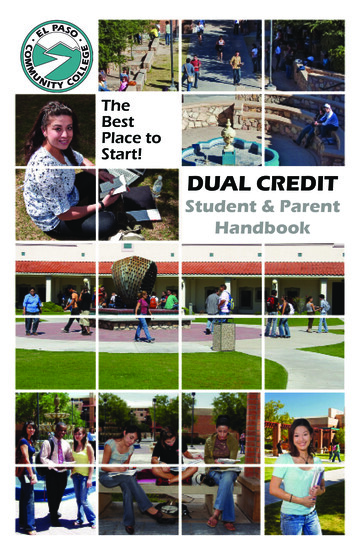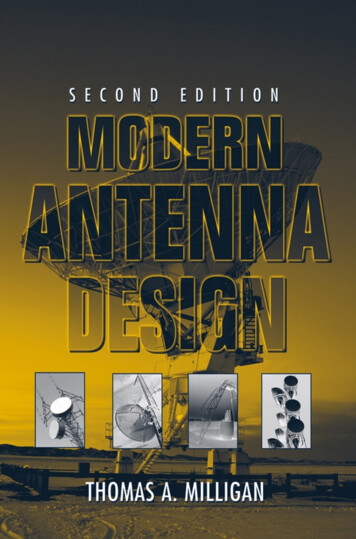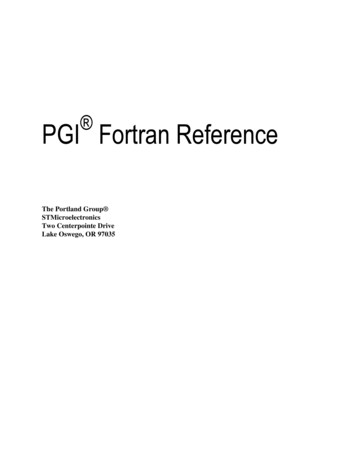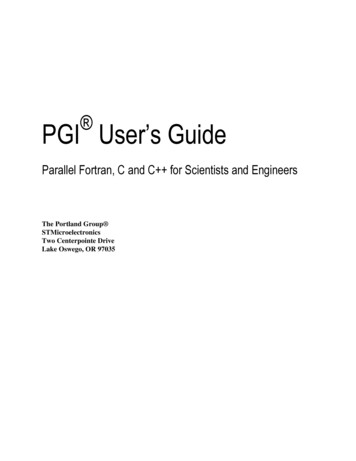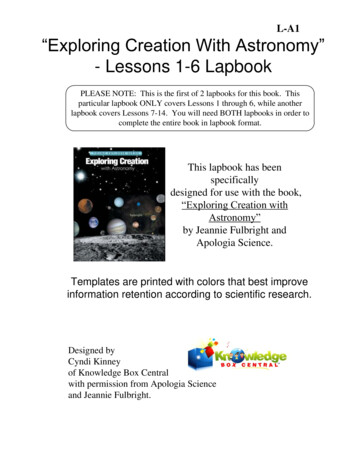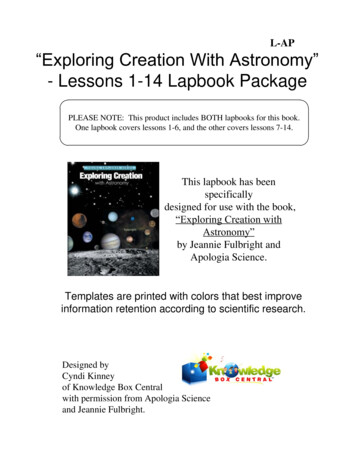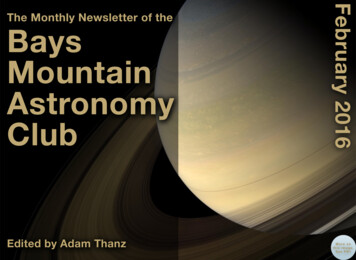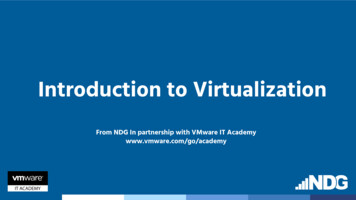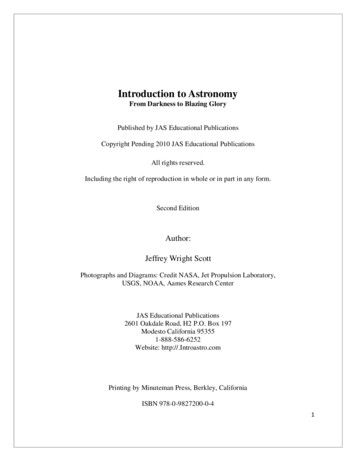
Transcription
Introduction to AstronomyFrom Darkness to Blazing GloryPublished by JAS Educational PublicationsCopyright Pending 2010 JAS Educational PublicationsAll rights reserved.Including the right of reproduction in whole or in part in any form.Second EditionAuthor:Jeffrey Wright ScottPhotographs and Diagrams: Credit NASA, Jet Propulsion Laboratory,USGS, NOAA, Aames Research CenterJAS Educational Publications2601 Oakdale Road, H2 P.O. Box 197Modesto California 953551-888-586-6252Website: http://.Introastro.comPrinting by Minuteman Press, Berkley, CaliforniaISBN 978-0-9827200-0-41
Introduction to AstronomyFrom Darkness to Blazing GloryThe moon Titan is in the forefront with the moon Tethys behind it.These are two of many of Saturn’s moonsCredit: Cassini Imaging Team, ISS, JPL, ESA, NASA2
Introduction to AstronomyContents in Brief Chapter 1: Astronomy Basics: Pages 1 – 6Workbook Pages 1 - 2 Chapter 2: Time: Pages 7 - 10Workbook Pages 3 - 4 Chapter 3: Solar System Overview: Pages 11 - 14Workbook Pages 5 - 8 Chapter 4: Our Sun: Pages 15 - 20Workbook Pages 9 - 16 Chapter 5: The Terrestrial Planets: Page 21 - 39Workbook PagesMercury: PagesVenus: PagesEarth: PagesMars: Pages17 - 3622 - 2324 - 2525 - 3434 - 39 Chapter 6: Outer, Dwarf and Exoplanets Pages:41-54Workbook Pages 37 - 48Jupiter: Pages41 - 42Saturn: Pages42 - 44Uranus: Pages44 - 45Neptune: Pages45 - 46Dwarf Planets, Plutoids and Exoplanets: Pages 47 -543
Chapter 7: The Moons: Pages: 55 - 66Workbook Pages 49 - 56 Chapter 8: Rocks and Ice: Pages 67Workbook PagesAsteroids:Comets: PagesMeteors: Pages- 7557 - 6468 - 6969 - 7172 - 75 Chapter 9: The Stars: Pages 76 - 87Workbook Pages 65 - 82 Chapter 10: Galaxies: Pages 88 - 93Workbook Pages 83 - 90 Chapter 11: The Universe: Pages 94 - 100Workbook Pages 91 -94 Chapter 12: History of Rocketry: Pages 101 - 105Workbook Pages 95 - 98 Chapter 13: Early Space Exploration: Pages 106 113Workbook Pages 99 - 102 Chapter 14: Manned Exploration 1959 -1976 Russians in Space: Pages 114 - 1184
Workbook Pages 103 - 106 Chapter 15: Manned Exploration Americans in Space 1959 – 1979: Pages 119 125Workbook Pages 107 - 110 Chapter 16: History of Space Explorations 1973 – 2009: Pages 126 - 139Workbook Pages 111 - 118 Chapter 17: SETI: Pages 140 - 150Workbook Pages 119 - 126 Chapter 18: The Night Sky: Pages 151 - 155Workbook Pages 127 - 130 Glossary: Pages 156 - 171 Index: Pages 171 -182 All homework assignments are located on the student DVD. Additional support items are found on the website:Introastro.com Reports and projects are supplied by teacher.5
This book is an introduction to Astronomy. While providing education, the book ismeant to spark passion for the science and the space industry by highlighting discoveries andoutcomes. Do you want to be a part of this exciting field? Our nation needs your help to continueto reach new heights in space science and industry. Be sure to check the end of your CD forprofessional opportunities.As we begin our study, take a moment to ponder where we are in space and what we liveon; a very special planet.A beautiful earthrise over our MoonPhoto courtesy of NAS6
A note to the reader:The Earthrise photo was taken by a man standing on the Moon, looking back at hishome planet, Earth. The ground upon which he was standing used to be a part of Earth. TheMoon used to be so close to us that much of the horizon would have been half covered by aprimordial moonrise. This desolate satellite is slowly drifting away, at a rate of a little over aninch a year.Something to ponder If I am looking through a telescope at a man up on the Moon, and heis looking up through telescope at me on Earth at the same time, how can we both be looking upat each other? Please discuss this dilemma.A virtual vacuum of space surrounds our planet. It can be airless, dark, and cold. Or it canbe radiation filled, bright and hot. You will learn why and what is in the Universe and how itworks.Please explore the book and DVD much as scientists explore the Universe, with aquestioning spirit and a curious mind. While reading you might want to ask yourself a fewquestions: What, or who, created the Universe? Does it exist for a purpose, or is it a random place that is devoid of reason? What unanswered questions remain about the Universe? What is in this book and DVD that could apply to your life?The information in this book represents a sampling of what has been discovered about ourplanet, our star, our solar system, and beyond. If you find this field of study interesting there arevideos, books, lectures, web sites, articles, conventions, workshops, magazines, and collegecourses available. Stay updated on the constant flow of information concerning new discoveriesresulting from the exploration of space.Jeff Scott7
Chapter 1Astronomy BasicsTour GuideR e q u ire d W o r k:H o m ew o r k C dW o r k bo o k : Page s 1 - 4Te st Pr o vide d byth e Te ac h e rR e q u ire d W o r k:H o m ew o r k D VDW o r k bo o k : Page s 1- 4Astr o n o m y Basic s Test(Te ac h e r Pr o vide d )1
been made over the last 40 years have beenheavily computer dependent. Modernastronomy relies upon technology, math andscientific method.Sk il ls an d To o l s o fth e tr ad eA photo from the Hubble Space TelescopeCourtesy NASAWhat is astronomy? When did itbegin? Astronomy is a study of virtuallyeverything beyond earth. The academicdiscipline includes studying planets, solarsystems, stars, galaxies, comets, asteroids,nebulae, moons and the Universe itself. Youwill learn about these fields of study as youread this book.Astronomy has produced a relativelynew field: astrobiology. So far, thisscientific endeavor only speculates aboutpossible alien life. But, as you will study inthis book, there are possibilities of alien lifeeven inside our solar system. Part of theastronomical science community is activelylistening for new signs of life in the cosmos(Another word for universe.). Thisorganization is called the SETI Institute.The abbreviation stands for: Search forExtra Terrestrial Intelligence.A very active part of astronomyconsists of teams of astronomers looking forexoplanets. These exoplanets are circlingstars outside our solar system. Literallyhundreds of these planets have been found.Several new ones are discovered everymonth.Many new discoveries that haveAstronomy is a visually - basedscience. The skill of careful observation isessential to understanding and discovery.Many astronomical skills were developed aslong as 5,000 years ago. Before writtenhistory began, people had noticed theinterrelationships between the Sun, Moonand the Earth. Observations resulted in arudimentary understanding of the timing ofdays, nights, monthly patterns of moonlitshapes and the seasons. Missing werescientific reasons for these events. Whenthere were no answers for naturaloccurrences, observers concluded that it wascaused by actions of the gods.Astrology and its astrologers werecosmos based, religious fortune tellers and“the gods’ will”, messengers. They closelystudied the stars, planets, the moon and sunand then tried to derive meaning for theirmovements. At times important decisions(war, marriages, coronations, etc.), weretimed because of predictions put forth bythese astrologers.Some of their observations werequite helpful. They could advise when toplant and harvest. They could determinewhen the next full moon night would occur.For those who lived near coasts, they couldpredict tides. They learned to use starpatterns for day and night time navigation.The skills of writing and mappingdrastically improved this combined religionand science of astrology and astronomy. By2
mapping and writing down observations,others were able to reutilize the savedinformation. Soon they were able to not onlyobserve, but also record and predictastronomical events over long periods oftime.The study of astronomy/astrologybecame an important development in thehistory of civilization. Skills of predictingweather patterns and seasons allowed man totime harvests. From this, each man nolonger had to just hunt, gather and maintainflocks. Agriculture was developed, creatinggreater food supplies this led to largerpopulations, spare time to build, invent anddevelop communities.Star observation and mapping allowed forthe navigation of new land and sea routes.Trade and exchanges of ideas developedbetween cultures. Over time, ancientcivilizations gained wealth, power andimproved technology based on the increasedamounts of food and trade, that was inspiredby studying the cosmos.Mathematics was integral to theadvancement of astronomical studies. Theancient people of Egypt and Greecedeveloped algebra and geometry. Throughthese math skills and little else, a Greekcitizen named Aristarchus, in 270 BC firstfigured out how far the moon was from theearth.This brings us to another importantcomponent: philosophy. Greek philosophersdeveloped this rational process of thought.This skill is the foundation of astronomy.We now call this process: the scientificmethod:1) Propose a question.2) Observe and research.3) Construct a hypothesis.4) Check it through experimentation.5) Draw a conclusion. (It may besupportive of the hypothesis, orprove the hypothesis wrong.If wrong, go back to step 3)6) Record or report the results.Often the results can bring additionalquestions.Maybe it was not always the“gods”: was there a natural, rational reason?Observation, recording throughpictures and writing, mapping the skies,advance mathematics, and scientificmethods are the foundations of astronomy.When paganism declined (worship ofseveral or many gods) and the influences ofmonotheism which is a worship of one allpowerful god, (Judaism, Christianity andIslam) arose, astrology as a popular religiondeclined. No more of Apollo riding the sunchariot across the sky!Astrology, as found today, is nolonger dominant over astronomy. It islooked upon as a superstition that tries to tiethe cosmos to fortune telling, personalitytraits and daily life.The Next Step:WesternEnlightenmentWestern culture suffered serioussetbacks when the Roman Empire wasshattered during the 5 th century AD. TheDark Ages began in Western Europe andcenturies of learning were lost. It took athousand years before science in westernculture regained what had been forgotten.The fifteenth and sixteenth centuries werethe time of the Renaissance (or rebirth) oflearning. This occurred mainly in Italy. Itestablished the scholastic ground work for3
modern astronomy. This was a time whenancient writings of a thousand years beforefound their way back into books of WesternEurope.(Some) of what was relearned turnedout to be false. But other knowledge,including advanced math and the rationalthought, were used as the skills needed toallow modern western culture to expandThe Catholic Church accepted theancient philosophies of the Universe,including Ptolemy’s theory that the sunorbited the earth and that the earth was thecenter of the universe. This was challengedby two men and one instrument. The menwere Nicholas Copernicus (NiclasKopernik) and Galileo Galilee and theinstrument was the telescope.Copernicus, a Polish mathematician,was educated in medicine, mathematics,astronomy and astrology in Poland and inrenaissance Italy. He proved through mathand observations the earth rotates on an axisand that the earth circles the sun, not visaversa. He published a treatise on this matterin 1543, the same year he died, called the DeRevolution Bus Erbium (in Latin). In it hecalled the heliocentric system the logicalexplanation of the earth’s relationship to thesun. This was first put forth by Aristarchus,a Greek philosopher who lived 1,800 yearsearlier than Copernicus.Some of his views were twisted andspun by a friend who had the book publishedand had changed the title to include the word“theory”. This same man, without consent,then wrote in the book that the heliocentricsystem may prove to be false. Copernicussaw his published book while he was in avery weak state on the last day of his life.He never read the revisions.At first those who opposedCopernicus’ writings were the newly risingProtestants. About 70 years later his ideaswere also opposed by the Catholic Church.Galileo Galilee brought them forth tosupport his own findings. He opposed theCatholic Church backed – Platonic (Plato)version, that the earth was at the center ofthe Universe and all celestial objects circlethe Earth. This belief was rather remarkableconsidering the fact that Galileo became apriest in his later years.Galileo did not invent the originaltelescope, but he was the one who firstturned it toward the Heavens.He was excellent at math and had akeen scientific mind. This combination oftechnology and skill advanced the studies onastronomy.Here are some Galilean quotes thatbest sum up his attitudes towards: science,ignorance, government and church:1) The Cosmos and Math:“(The universe) cannot be read until wehave learnt the language and becomefamiliar with the characters in which it iswritten. It is written in mathematicallanguage and the letters are triangles, circlesand other geometric figures, without whichmeans it is humanly impossible tocomprehend a single word.”2) Governing the Scientists:“In questions of science, the authority of athousand is not worth the humble reasoningof a single individual.”3) The Church and Science:“I do not feel obliged to believe that the4
same God who endowed us with sense,reason and intellect intended us to forgotheir use.”4) The Second Guessers and:Detractors:“All truths are easy to understand once theyare discovered; the point is to discoverthem.”Galileo, an Italian born 21 years afterthe death of Copernicus, studied medicinebut also had a keen interest in mathematicsand astronomy. Although he is best knownfor his ideas on astronomy, he alsodiscovered the secrets of the pendulum, laterthe basis for his ideas about making apendulum clock. (An example of this styleo
Astrology and its astrologers were cosmos based, religious fortune tellers and “the gods’ will”, messengers. They closely studied the stars, planets, the moon and sun and then tried to derive meaning for their movements. At times important decisions (war, marriages, coronations, etc.), were timed because of predictions put forth by these astrologers. Some of their observations were quite .
